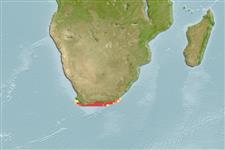Elasmobranchi (squali e razze) (sharks and rays) >
Carcharhiniformes (Ground sharks) >
Pentanchidae (Deepwater catsharks)
Etymology: Halaelurus: halos (Gr.), sea; ailouros (Gr.), cat, probably an allusion to the vernacular “catshark,” so named for its cat-like eyes. (See ETYFish); natalensis: -ensis, Latin suffix denoting place: the coast of Natal, South Africa, type locality. (See ETYFish).
More on author: Regan.
Environment: milieu / climate zone / depth range / distribution range
Ecologia
marino demersale; distribuzione batimetrica 0 - 172 m (Ref. 5578). Subtropical; 33°S - 35°S
Southeast Atlantic: Cape Agulhas to East London in South Africa. Until recently, two species were confused under this name, the present one and the recently described Halaelurus lineatus (Ref. 244).
Size / Peso / Age
Maturity: Lm ? range ? - ? cm
Max length : 45.0 cm TL maschio/sesso non determinato; (Ref. 244); 47.0 cm TL (female)
Spine dorsali (totale): 0; Raggi dorsali molli (totale): 0; Spine anali 0; Raggi anali molli: 0. A catshark with a prominent upturned knob on the snout, a broad head, and with no spots on the body (Ref. 5578). Yellow-brown in color, with pairs of broad, vertical, dark brown stripes outlining dusky saddles (Ref. 5578), cream ventrally (Ref. 5510).
Found on the continental shelf, from close inshore to deeper water (Ref. 244). Feeds mainly on small bony fishes and crustaceans, also cephalopods and small elasmobranchs (Ref. 244).
Life cycle and mating behavior
Maturità | Riproduzione | Deposizione | Uova | Fecundity | Larve
Oviparous, with 6 to 11 egg-cases per oviduct (commonly 6 to 9) at a time (Ref. 244). Egg cases retained until embryos are well-advanced (Ref. 5578).
Compagno, L.J.V., 1984. FAO Species Catalogue. Vol. 4. Sharks of the world. An annotated and illustrated catalogue of shark species known to date. Part 2 - Carcharhiniformes. FAO Fish. Synop. 125(4/2):251-655. Rome: FAO. (Ref. 244)
IUCN Red List Status (Ref. 130435)
Threat to humans
Harmless
Human uses
Warning: mysqli::__construct(): (08004/1040): Too many connections in /var/www/html/includes/func_getlabel.php on line 46
Can't connect to MySQL database (fbapp). Errorcode: Too many connections
